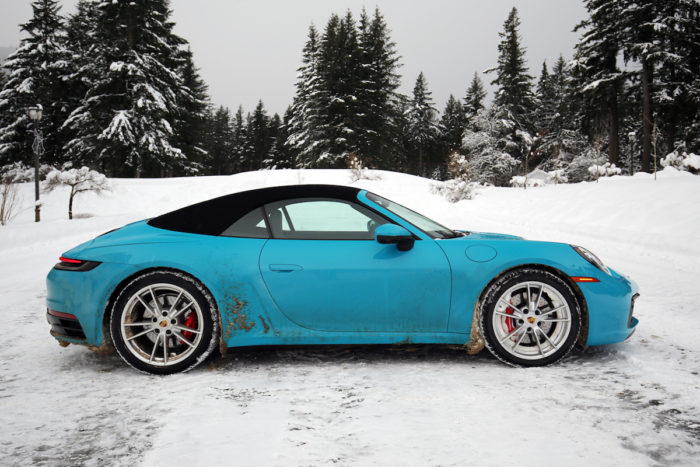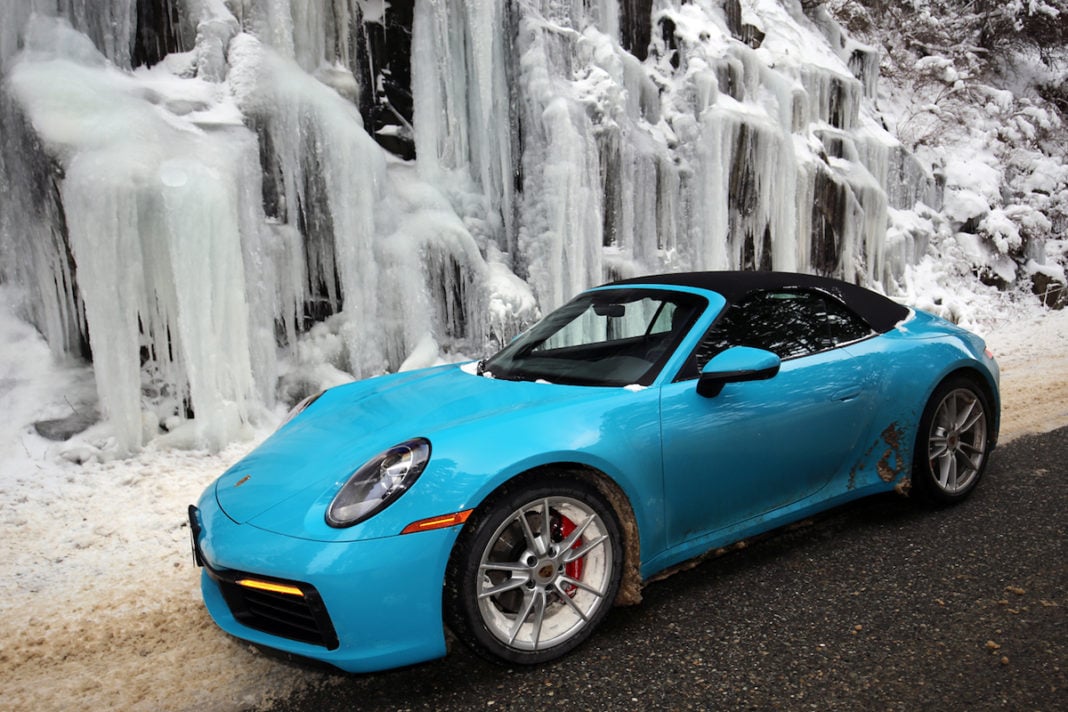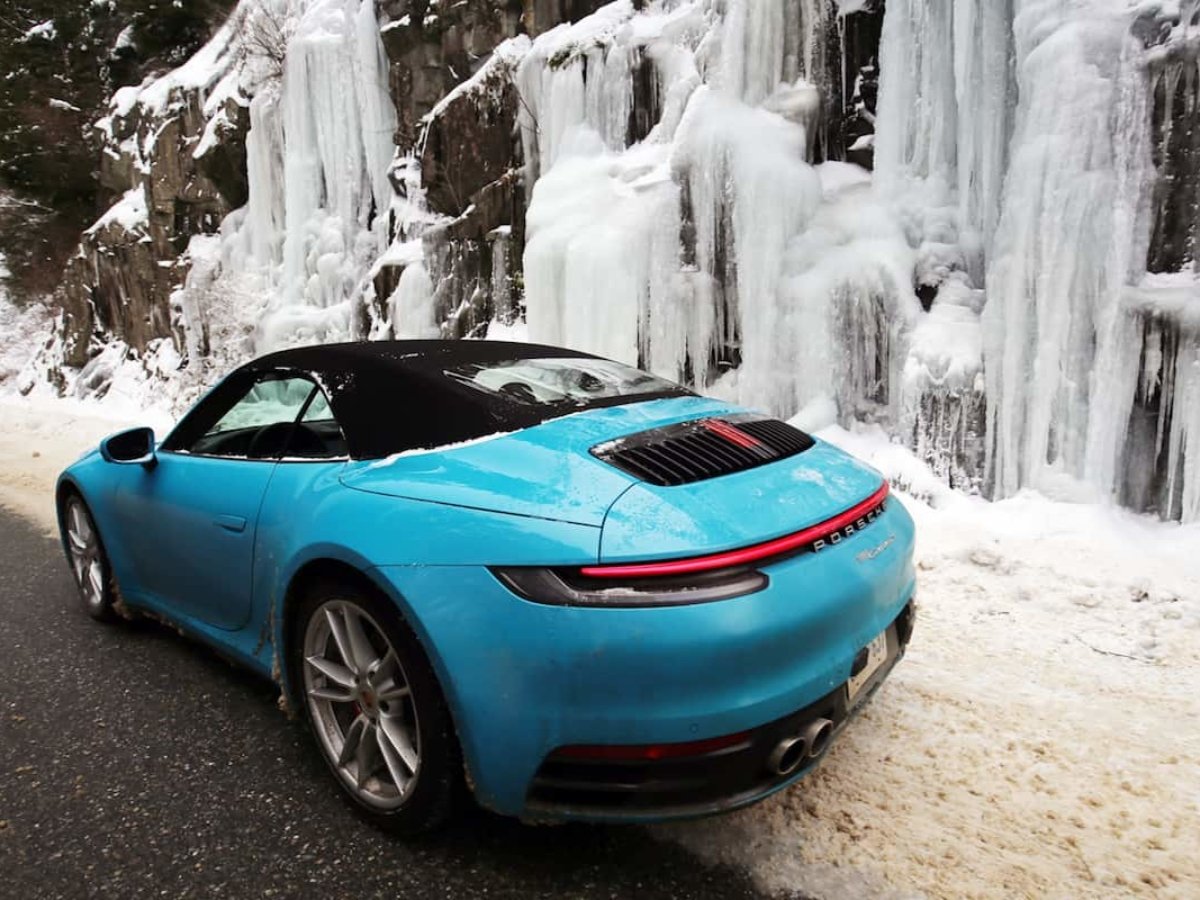Porsche has just released the eighth generation of its venerable 911, this time code named 992. This is the first redo since 2012, and the car is longer and wider than the outgoing model, but retains the same wheelbase.
Performance: lighter 911 with more horsepower
Interestingly, Porsche chose to release one of its hotter variants – the 911 Carrera S -first, and our test vehicle arrived in Cabriolet form. The body is lighter, and stiffer, as Porsche has increased the amount of aluminum used in this car’s construction two-fold. The suspension has been reworked, as have the brakes, and for the first time, the car now rides on different sized wheels front and back (20- and 21-inch respectively).
The Carrera S is powered by a 3.0-litre twin-turbo flat six-cylinder engine fitted just aft of the rear axle which generates a healthy 443-horsepower (up 23 from the previous car) and 390 lb.-ft of torque. A revised 8-speed PDK is the only transmission offered at the moment, but a 7-speed manual box is soon to be on the menu.
This combination will gallop from 0-100 in a blistering 3.9 seconds if the driver elects to use the onboard launch control.
There is a new compact gear lever. You simply push it forward for reverse, back for drive. The selected gear is displayed in a small display at the base of the centrally mounted tachometer. Of course paddle controls are fitted to the wheel giving the user the ability to fully exploit the speed of the 8-speed dual-clutch PDK automatic.
Exterior styling: wider proportions
Fresh new styling cues abound, and all 911 models will feature the wide body look that used to be reserved for 911 Turbo and 4S models. The familiar profile continues on well into its sixth decade, although the entire body appears bigger, flatter, and meaner. The new car has a presence, which represents the perfect mixture of power and grace.
A wide grille with continuously variable flaps in the outboard vents to feed air to the engine and turbochargers (and reduce drag and fuel consumption) gives the car a fresh new face, and advanced LED lighting systems feature prominently front and rear. The car’s tail is automotive sculpture, with a full-width active spoiler to help keep the car planted during high-speed cornering manoeuvres.
Interior: updated cabin thanks to the Panamera
The interior is revolutionary for a 911 product, and now incorporates many of the niceties and design elements that have been developed in other Porsche products like the executive class Panamera. The 2- plus-2 seating arrangement remains, but the look and feel of the cabin, switchgear and instruments propels the platform into the future.
Technology abounds, from a new three panel virtual gauge clustre to a cutting-edge touch-screen infotainment centre, and a wide array of safety features complete the package. Optional upgrades include night vision (Night View Assist) and a surround view camera system. In short, it will be easy to keep up with the Joneses in a new 911.
Test Drive: how does the new 2020 911 Carrera S convertible handle?
My week with the beautiful Miami Blue test unit corresponded with the arrival of a period of rather extreme winter weather. Mother Nature had deposited a healthy amount of snow, and temperatures had plummeted to levels typically unheard of in southwest British Columbia.
Roads were closed, ice was in abundance, and extreme winds made conditions extra treacherous.

Unfortunately, these conditions robbed me of the chance to really evaluate the true potential of the car’s performance and handling. However, they offered me the opportunity to evaluate whether or not a high-performance GT like the 911 S is an effective vehicle when faced with winter conditions. Luckily the car had been fitted with a new set of Continental Winter Contact TS 860S performance tires, a speed-rated winter boot that comes with an outstanding reputation for grip and wet-weather performance.
The 911 Carrera S Cabriolet is a rear-wheel-drive sports minded vehicle which derives its motivation from a powerful engine fitted to the rear. On paper, this sounds like a disaster waiting to happen, but in reality, the car, and both my mind and body emerged unscathed. In fact, I would guess that the experience of driving this car in adverse conditions has probably made me a better driver.
What did I learn from this experience? I came away with the knowledge that with only minor changes to my everyday driving style the rear-wheel-drive Porsche was able to navigate safely through compact snow and over surface ice with relative ease. The trick seemed to be to focus on applying smooth and more deliberate inputs from the driver, such as consistent levels of pressure on the accelerator and brake pedals as well as making very slight corrections to the steering as needed. The new car’s chassis and suspension are phenomenal, so I could feel the car’s dynamic movement through the seat, and if the tail started to wag I knew to lighten my pressure on the gas pedal.
The car tracked straight and true in the direction it was pointed, and unless you came across a deep blanket of unplowed snow, the car seemed to relish the challenge.
The 911 Carrera S features four drive modes – Normal, Wet, Sport and Sport Plus – which allow the driver to adjust suspension and throttle response. For much of my week I elected to use the Wet setting, as this mode has been engineered to excel when the roads get slippery. The system automatically adjusts both the traction and stability controls so that they will react instantaneously. Despite the car’s low ground clearance and stance it managed to soldier through the snow and frozen debris with confidence and a level of surefootedness that I did not expect.
In fact, the only real drawback I could see was that the wheel wells would pack with frozen slush as the warm tires melted the snow and it would find it difficult to clear. Luckily this didn’t hamper forward momentum as the tires would scythe through the deposited berm, which was easily knocked out with a snow brush whenever I parked the car.
The car tracked straight and true in the direction it was pointed, and unless you came across a deep blanket of unplowed snow, the car seemed to relish the challenge. This car featured rear axle steering, a $2,390 option designed to enhance handling and increase stability.
When operating at low speeds, the system steers the rear wheels in the opposite direction to that of the front wheels, which effectively reduces the turning radius and improves steering response. When the car is driven at higher speeds, rear axle steering steers the rear wheels in the same direction as that of the front wheels which enhances overall driving stability and agility. Having this system onboard blessed the car with nimble and precise handling that helped to give me more confidence behind the wheel.
The transmission worked to keep the car in a suitable rev range given the conditions and inputs, and although my car didn’t have the optional sport exhaust, it still made wonderful sounds. On the few occasions I managed to exploit a break in the weather and find clear roads I shuffled through the drive modes to get a better feel for this novel steering technology, and after experiencing it firsthand, I would say that it is a good investment.
Takeaway: the ultimate 4-season convertible coupe?
While the owners of most sports cars tend to park them for the winter months in an effort to preserve their appearance and reduce the amount of wear-and-tear to components, it seems unfortunate to rob yourself of the joy that comes from piloting such vehicles for such an extended period of time. This is especially true given the capabilities of the various safety technologies available on such cars and the advances that have been made in winter tire designs.
Modern convertibles, like this Cabriolet, have well-insulated tops fitted to very stout frames, so trying to maintain cabin comfort and interior noise levels is no longer an issue, and fast deploy mechanisms and efficient heating systems even allow top-down cruising on a whim.
Is the new Porsche Carrera S Cabriolet suitable for four-season operation? The car is more than capable, so the answer is yes. The trick however, is to stick to regularly maintained roads (read: serviced by a plough), and to mount proper winter tires. If you are prepared to exercise caution and readily adapt to conditions, then cars like this can, and should be driven.
Pros:
The 911 now boasts a modern interior and the latest technology
More powerful turbocharged engine offers improved fuel efficiency
An iconic shape with unmatched curb appeal
Cons:
Options are pricey, even for a German automobile.
The tiny shift lever looks, and feels, odd
Rear seats are still best used for gym bags and storing your coat.

Technical Specifications: 2020 Porsche 911 Carrera S Cabriolet
- Base price (MSRP): US$126,100, C$143,700
- Price as tested: C$173,310
- Body Style: Compact, four passenger sports convertible
- Layout: Rear-engine, rear-wheel drive
- Engine: 3.0-Litre twin-turbocharged DOHC 24-valve flat-6
- Horsepower: 420 hp @ 6.500 rpm
- Torque: 390 lb-ft @ 2,300-5,000 rpm
- Transmission: 8-speed dual-clutch automatic
- Brakes (front/rear): Disc/disc



